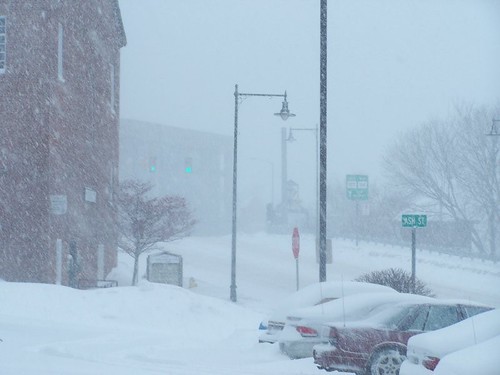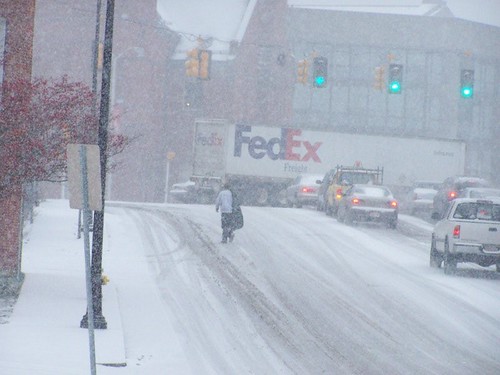My friend Leo Jodoin emailed me Friday night: Long-time councilor Leonard F. O'Leary passed away. I was never a consituent of Lenny's, as my family moved out of Gallows Hill when Frances Grace was still councilor, but he and I and our mutual friend Leo Jodoin, worked together on Leo's Salem Senior Recognition Days.
The photo above shows Lenny, my ward councilor and Commission liason Mike Sosnowski and Leo, together at last year's Recognition Days ceremony. We had wanted Lenny to be the master of ceremonies in 2007 as he had been for the past two years of the event, but he had been sick that day.
Lenny was a frequent guest on Salem Now and a very familiar presence at SATV.
I'm normally deeply cynical about local politics, but we and Salem will really miss Lenny. Many of the really influential old-timers in Salem that remember life before condos, history as property values, and "hip, cool, dynamic residents", the truly living history, are beginning to pass from us.
We will come to regret their passing bitterly, as in many ways Lenny and others of his generation were the best of Salem, in ways I don't expect my generation or even the one before it, to ever match.
Update: The 2008 Salem Senior Recognition Days is dedicated to Lenny.
Sunday, December 23, 2007
Lenny O'Leary is no longer with us
Saturday, December 22, 2007
More icy sidewalks, hazardous for those in wheelchairs
Continuing the last topic of dangerous walking, we at the Salem Commission on Disabilities could just specialize in sidewalks--we'd still have more work than we could handle!
This quote from today's Globe:
If you think it has been tough trudging along Boston's snowy, icy, slushy streets and sidewalks this week, try it in a wheelchair.
The city has been a frozen obstacle course for people with disabilities, a problem compounded by businesses, institutions, and state and city agencies that have ignored their obligation to clear the way for people in wheelchairs to get from their homes to city streets, according to an advocacy group for the disabled.
Among those failing to sufficiently clear away snow have been the state's Division of Conservation and Recreation, Northeastern University, and the Boston Symphony Orchestra, said the organization, called the Neighborhood Access Group.
"It's pervasive, unrelenting, and demoralizing," said the head of the group, John Kelly. He said some members may not attend their own holiday party this afternoon at a housing complex in the Fenway, because sidewalks in the vicinity are still impassable, crosswalks blocked, and wheelchair ramps treacherous.
"Many of us can't even leave our houses," he said. (emphasis added)
Several years ago, the Commission went through this problem with the Post Office in Salem. This building had a ramp retrofitted to it, running in a serpentine route to the right of the main entrance.
It was closed during the winter due to ice dams building up on the roof. Repairs to the roof were tied up for a long time due to bureaucracy. Wheelchair users were supposed to go in through the rear of the building, which is employees-only and a private area. In the meantime, 9/11 happened, and the post office was somehow convinced that it might not be a great idea for the chair-using public to pass through sensitive areas. The roof got its repairs this year and the ramp is now open, at least so far this winter.
This season, one of my fellow commissioners is fighting with the YMCA over snow removal. The YMCA building on the corner of Sewall & Essex is also the site of the Zisson elderly/disabled housing complex. The van space in front of the building has been continually blocked by an endless array of snowbanks, construction vehicles, illegally-parked cars and other such obstacles.
The parking lot, as most parking lots around the city, is choked with snow. Elderly vans and chair cars can't take on or let off their passengers. Snowmelt makes things worse as huge puddles (1" to as much as 3" deep!) form at the base of ramps where they meet the street surface. It's bad enough just walking through an inch of water, never mind in a chair or on crutches! Also, many crosswalks are located at or near storm drains and these are often clogged with snow allowing enormous curb-swallowing rivers to form!
Boston's Neighborhood Access Group is on the case! They have an excellent blog with a lot of incriminating pictures that clearly show icy sidewalks impassible to the disabled.
Most able-bodied people navigate these crossings with a lot of frustration but take them for granted; it's winter, after all. I used to do the same thing. Lately, I've started looking at the three-foot snowbanks I find outside the grocery store and saying, "Why do I have to climb over this for another year in a row! Waiting in the street for the bus doesn't build character!"
I wish I had the answer.
Globe article: Icy walkways create a special challenge for those in wheelchairs - The Boston Globe
Wednesday, December 19, 2007
Dangerous Walking
Every year that there's significant snow in the winter (not last year), there are plows. And covered sidewalks. And steep snowbanks. This winter is starting out like usual, and very tragically for one person.
In Blackstone, a woman walking home with her groceries, unable to walk on the sidewalk due to snowbanks, was run down by a snowplow and killed.
Several years ago, we in the disability community in Salem lost one of our best people, Tiffany Park, when she and her scooter were run down in Lynn, when she was on the way to church services. She was also forced to use the street.
For the most part, I accept winter and the compromises one has to make. I accept that I might have more problems getting around.
But I am perennially dismayed and frustrated at the great number of unplowed sidewalks in and around Salem. City ordinance requires sidewalks to be shoveled after a storm. But that's not the biggest problem.
The way in which streets are plowed after storms is even worse. Imagine a street with a T intersection, crossed by another street or, most commonly, a driveway. Usually, one plow driver from the DPW will take care of the street. A private operator with another truck or a Bobcat will do the driveway that might go back into a parking lot. The two plows will work and move the snow.
The snow ends up on the sidewalk. The natural action of the plows pushes snow to the sides, and when a plow crosses a street to do a driveway, the snow builds up in huge pillars at the corners.
Even if sidewalks are plowed in front of any one building, one often cannot go on the sidewalk; it may be blocked by a pillar, or black ice at a driveway, etc.
For walking any distance, I am forced in the street. This is downright scary.
My neighborhood, the street grid around St. Peter & Federal is one example that proves my point, with its many driveways into 10 Federal, St. John's and St. Peter's Church. Even when an individual building is plowed, the driveways make it very treacherous to walk. The Museum Place lot has no plowed sidewalks at all.
As well, many commercial establishments will plow their parking lots but not the public sidewalks that front them. The most dangerous place in Salem, I'm convinced, is the bus stop outside Market Basket (northbound Highland Ave.) Jersey barriers are more forgiving than the frozen snowbanks that cover the sidewalk there. It is not possible for even an able-bodied person (and I am NOT mobility-impaired!) to mount the snowbanks to wait for a bus.
Snow plowing and its responsiblities (and fines!) have been very contentious in Salem in past winters. This has been discussed at our commission meetings; unfortunately, too many feel that people complaining about sidewalks should move to Florida or stay homebound in the winter. I'm certainly not thrilled about bringing this issue up every year.
Source: WHDH-TV - New England News - Police seek snow plow driver after hit-and-run death
Sunday, December 16, 2007
Thursday, December 13, 2007
First storm of Winter '07-'08, continued
UPDATE: The final snow total at my house (St. Peter @ Bridge) is 9".
Sunday, December 2, 2007
The 2 x 10 Program: Leveling the playing field for the blind in Massachusetts
I was alerted to an item from the Perkins School for the Blind:
Did you know that over 35,000 people in Massachusetts are registered as legally blind? This does not account for those who are unregistered or who have severe vision loss but do not qualify as legally blind. The unmet needs among this group are many. They are significant and directly impact many aspects of life for each individual. For example, the survey showed that:
- 77% of blind residents under the age of 65 are unemployed
- 41% of blind residents identify transportation as their greatest program
- Only 18% of blind residents use a computer
- 38% of blind adults have limited social and recreational lives because of their vision.
To help those legally blind and low vision citizens, Perkins has announced the 2 x 10 Program that calls for Massachusetts to allocate $2 million by 2010 in the House budget towards programs for the blind and visually impaired.
There is an online petition that's addressed to Deval Patrick, JudyAnn Bigby (Massachusetts Health and Human Services) and Leslie Kirwan (Secretary of Administration and Finance). You can fill it out, but I think written letters would have more impact.
Of course, the Salem Commission on Disabilities will almost certainly support this, but if you or a loved one are vision-impaired, I urge you to write them yourself with your story.
Hat tip to Blue Mass. Group:: leveling the playing Field for Mass. Blind



